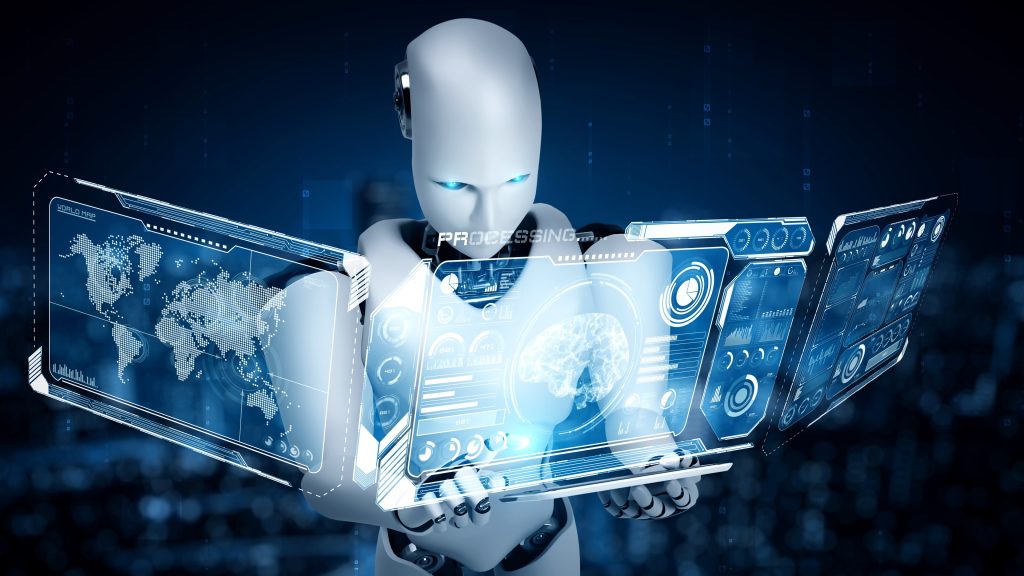We may not always notice it, but artificial intelligence (AI) is already firmly entrenched in our daily lives. Whether it's facial recognition that unlocks your phone, a chatbot that answers a question at lightning speed, or streaming services that are increasingly predicting what you like – AI works in the background. However, what we are already experiencing is just the beginning. In the future, AI is likely to play a key role in things like faster medical diagnoses, driverless cars, and robots that increasingly understand and respond to their environment. The potential is huge, and we are only at the beginning of what is possible.
Artificial Intelligence: a brief explanation
AI, or artificial intelligence, makes it possible for computers and machines to do things that we normally do ourselves, such as learning, making decisions, and solving problems. Its operation is by extracting information from the environment, learning from it and then taking actions to achieve the goal we had in mind. Sometimes the rules are set in advance by humans, but often AI itself discovers structure in huge amounts of data. These traits and ability to learn and improve on its own are what make AI so special and powerful.
What is AI? An explanation of the main shapes
AI, or artificial intelligence, refers to technologies that mimic human thought processes and behaviors. Within this broad field, various techniques have been developed, each with unique applications. Below we highlight four commonly used methods:
1. Supervised machine learning
In supervised machine learning, the algorithm works with pre-labeled data. People have already organized the data, for example by adding names to faces in photos. The algorithm learns from this and can then perform similar tasks independently. Think, for example, of facial recognition on platforms such as Facebook, where the system can automatically tag people in photos after you have indicated them once.
-
Unsupervised machine learning
Unlike supervised learning, the algorithm does not get a predetermined outcome here. It learns to discover patterns and connections in large amounts of data. This is reflected, for example, in music services that recommend songs based on your listening history. The algorithm looks for matches on its own and clusters this data to make personalized recommendations. -
Reinforcement learning
Reinforcement learning is a type of machine learning where, for example, a robot or a self-driving car becomes smarter through 'rewarding and punishing'. In other words, by trying and making mistakes, the machine becomes more intelligent. Learning through experience is therefore what it's all about. -
Deep learning
Deep learning works with a kind of networks that are designed after the example of how our brain works. These networks consist of different layers, with each layer picking up something specific from the data. As a result, the algorithm is getting better and better at performing complex tasks. Think, for example, of a system that recognizes a cat in a photo. By analyzing thousands of images, it learns to distinguish details such as ears, eyes, and fur. Deep learning is also at the heart of technologies such as self-driving cars and real-time speech translation.
AI: the engine behind progress
The different methods within AI make the technology extremely versatile. From smart recommendations to complex neural networks, AI continues to have a huge impact on how we use technology in everyday life. It is a driving force for innovation and continues to create new opportunities.

Why artificial intelligence takes us further
Artificial intelligence (AI) has many advantages compared to classic methods. Thanks to technologies such as deep-learning, we can solve problems that were not possible before, such as automatically recognizing objects in photos. Also, AI algorithms work faster, more accurately, and more efficiently than humans. They know no fatigue or boredom, which makes them ideal for large-scale applications. Think of processes that stimulate economic growth, provided that we take into account important values such as privacy and equal rights.
Faster, smarter, and safer with AI
AI can analyze large amounts of data at lightning speed and find connections that humans would miss. This not only makes processes faster and cheaper, but also a lot more accurate. In addition, AI can improve our safety, for example by detecting fraud, recognizing suspicious situations via smart cameras, or by deploying robots in dangerous places such as mines or unstable caves. Do you want to know more about how AI is used in different sectors? Then take a look at the article by the National Inspectorate of Digital Infrastructure (RDI) about application of artificial intelligence.
AI in everyday life
In addition to business and social applications, AI also makes our lives a lot easier. Think, for example, of Netflix, which effortlessly recommends movies and series based on what you've watched before. Or a smart lawnmower that keeps your garden perfectly up to date, even in hard-to-reach places. Smart thermostats go one step further: they learn your lifestyle habits and ensure that your home is always comfortable when you come home. It's those little things that make life just that little bit more pleasant.
